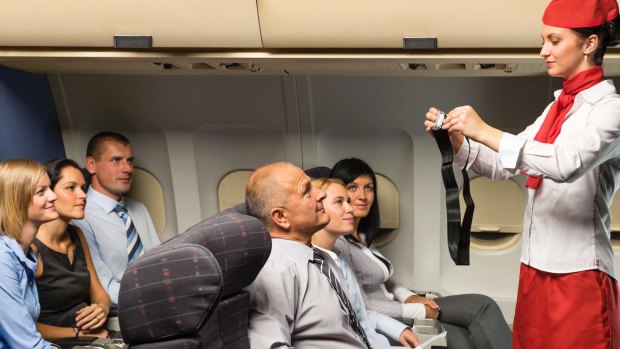This was published 8 years ago
Seatbelts on planes are pointless? The truth about wearing them
By Natalie Paris

How useful is a seatbelt in the event of a crash?Credit: iStock
You know the drill. "Seatbelts should be worn at all times while the seatbelt sign is on." But how useful is one really in the event of a crash?
Suggestions on the internet that belts are only necessary to aid the identification of passengers after an accident are complete rubbish, according to one air stewardess.
"That is the stupidest thing I've ever heard," said Heather Poole, an American air stewardess and the author of Cruising Attitude: Tales of Crashpads, Crew Drama and Crazy Passengers.
"For one, passengers switch seats all the time and we're not chasing them down trying match up names to seat numbers.
"Also there are quite a few airlines, like Southwest Airlines, who don't even have seat assignments. It's first come first serve."
She said that the reason cabin crew check that passengers are belted in is due to injuries that can occur during turbulence.
"The reason you must wear a seat belt, flight crew included," she explained, "is because you don't want the plane coming down on you.
"People think they're lifted up in the air during turbulence. The truth is the plane drops. It comes down hard and it comes down fast and that's how passengers get injured - by getting hit on the head by a plane."
According to the Federal Aviation Administration, between 1980 and 2008 there were only 234 accidents involving turbulence. Of these, Ms Poole said that they resulted in 298 serious injuries and, worse, three fatalities.
"Of the three fatalities, two passengers were not wearing a safety belt while the seat belt sign was illuminated," she said. "Of the 298 seriously injured, 184 were flight attendants.
"I bet you they were probably checking to see if passengers were strapped in. That or they were quickly trying to lock up everything in the galley so things didn't go flying."
Ms Poole said that she always ensures her nine-year-old son wears his seatbelt, even when the sign is off.
"You never know when it's going to happen, and it happens, even when the sign is off. That is what is called clear air turbulence. Turbulence is no joke. People get hurt."
The idea that being buckled up will slow you down should you need to evacuate has been discredited by industry experts for the same reason. It's much harder to find your way to the exit if turbulence has left you concussed.
"Certain events, such as clear air turbulence, can occur without warning, and can cause unexpected changes in movement to aircraft," said a spokesman for the Civil Aviation Authority (CAA).
"Seat belts are required and designed to ensure passenger safety and reduce the risk of injury, particularly during deceleration, turbulence and unplanned or difficult to predict events."
"We know that in the rare event of an accident, seatbelts save lives," said a British Airways spokesman. "That's why we always advise our customers to wear them and our cabin crew carry out regular checks."
So it seems that fliers would do well to heed the advice from cabin crew and belt up.
Last year, severe turbulence caused three EasyJet crew members to "hit the ceiling" over Italy, according to a passenger eye-witness, with one sustaining a hip injury.
Let the broken ankle suffered by another member of easyJet's cabin crew be a final warning.
So called "clear air turbulence" was so severe on a flight from Gatwick airport that one staff member broke an ankle and another suffered severe bruising.
Video footage shows passengers shrieking as the cabin flies up and down. None of the passengers, who were seated, were injured.
The Telegraph, London
Sign up for the Traveller newsletter
The latest travel news, tips and inspiration delivered to your inbox. Sign up now.